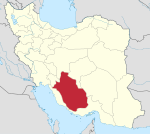in Persian: بیشاپور | |
 The ruins of Bishapur | |
| Alternative name | Bishâpûr |
|---|---|
| Location | Kazerun, Fars Province, Iran |
| Coordinates | 29°46′40″N 51°34′15″E / 29.77778°N 51.57083°E |
| Type | Settlement |
| History | |
| Builder | Shapur I |
| Founded | 226 AD |
| Cultures | Persian (Sasanian era) |
Bishapur (Middle Persian: Bay-Šāpūr; Persian: بیشاپور, Bishâpûr) was an ancient city in Sasanid Persia (Iran) on the ancient road between Persis and Elam. The road linked the Sassanid capitals Estakhr (very close to Persepolis) and Ctesiphon. It is located south of modern Faliyan in the Kazerun County of Pars Province, Iran. Bishapur was built near a river crossing and at the same site there is also a fort with rock-cut reservoirs and a river valley with six Sassanid rock reliefs.
YouTube Encyclopedic
-
1/5Views:2 6121 3641 000780875
-
Iran Bishapur Sasanid Persia ancient city بيشاپور شهر باستاني ساساني ايران
-
ANCIENT CITY OF BISHAPUR - IRAN
-
Iran Bishapur Pasargadae 2001
-
Iran - Bishapur and Tang e Chogan 2016
-
Iran Susa to Bishapur 2001
Transcription
History

The name Bishapur derives from Bay-Šāpūr, which means Lord Shapur.[1]
According to an inscription, the city itself was founded in 266 AD by Shapur I (241-272), who was the second Sassanid king and inflicted a triple defeat on the Romans, having killed Gordian III, captured Valerian and forced Philip the Arab to surrender. The city was not a completely new settlement: archaeologists have found remains from the Parthian and Elamite ages. The city remained important until the Arab conquest of Persia the rise of Islam in the second quarter of the 7th century AD.
The city has a rectangular plan with a grid pattern of regular intra urban streets, resembling Roman city design. This design was never repeated in the architecture of Iran.[2]
Excavations and research

The site was cleared by the Russian-French archaeologist Roman Ghirshman in the 1930s. The British archaeologist Georgina Herrmann has also written a book about the Sasanian rock reliefs in Bishapur which was published in 1980.[3]
Decoration
The main part of the excavations took place in the royal sector, in the east of the city. A water temple, interpreted as an Anahita temple, was erected near the palace.
The floor was paved with black marble slabs, with a mosaic border. At the top of each alcove there was a picture of women naked under their transparent veils: courtesans, musicians, dancers, women twisting garlands, together with a few richly attired noble ladies.
-
Persian-Roman floor mosaic detail from the palace of Shapur I at Bishapur. Presently housed in the National Museum of Iran
-
Sasanian era floor pavement marble mosaic excavated by Roman Ghirshman, c. 1939–1941. Presently housed in the Louvre
-
Jars discovered in Bishapur
See also
References
- ^ "Welcome to Encyclopaedia Iranica".
- ^ Salma, K. Jayyusi; Holod, Renata; Petruccioli, Attilio; André, Raymond (2008). The City in the Islamic World. Leiden: Brill. p. 174. ISBN 9789004162402.
- ^ http://www.worldcat.org/title/sasanian-rock-reliefs-at-bishapur-part-1-bishapur-iii-triumph-attributed-to-shapur-i/oclc/59815517&referer=brief_results[bare URL]
External links
- Bishapur; Photos
- Bishapur, Photos from Iran, Livius Archived 2016-11-10 at the Wayback Machine.
- City of Bishapur (Video)






